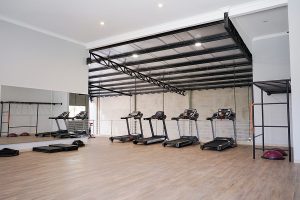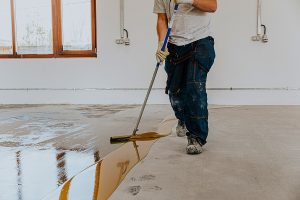When you’re moving barbells and bodies all day, the floor isn’t just décor, it’s safety gear. A decorative epoxy application in gyms can do more than look sharp; built and maintained correctly, it supports traction, hygiene, visibility, and durability so members train with confidence and staff spend less time on repairs.
Designed Traction for Fewer Slips
Slip, trip, and fall prevention starts with the walking surface. OSHA’s Walking-Working Surfaces rule requires employers to keep floors “in a safe condition,” inspect them regularly, and control hazards, expectations an epoxy system can help you meet when it’s specified for traction and maintained.
Modern traction targets are often discussed using DCOF (dynamic coefficient of friction). The ANSI A326.3 standard describes methods for measuring DCOF on hard surfaces; many resinous flooring vendors publish guidance that relates broadcast aggregates and textures to DCOF goals for wet and dry zones. In short, you can tune an epoxy gym floor’s grip to the space with more texture near water fountains or turf transitions, and smoother under selectorized equipment.
Because “epoxy equals slippery” is a common myth, it’s worth stating plainly: smooth, glossy epoxy can be slick when wet, but slip-resistant broadcasts (quartz, aluminum oxide, etc.) and matte topcoats dramatically change that equation. The point is to design for your moisture profile, not accept a one-finish-fits-all surface.
Seamless, Nonporous Surfaces That Clean Fast
Gyms demand rapid cleaning between classes and at close. Seamless resinous floors eliminate grout lines and open joints where grime can hide, so soil and sweat film lift more easily during routine maintenance. Industry guidance highlights that seamless, chemical-resistant systems tolerate repeated disinfectant use without breaking down, key for locker rooms, studios, and free-weight areas that are cleaned many times a day.
The CDC’s facility guidance is straightforward: clean high-touch surfaces regularly; disinfect when needed. A nonporous, easy-to-wipe floor helps teams follow that playbook efficiently.
Chemical Resistance to Daily Disinfectants
Post-workout sprays and mop buckets aren’t gentle. Epoxy gym flooring systems are available with topcoats formulated to resist scuffs, bleach solutions, alcohols, and other common gym disinfectants, reducing whitening, softening, or early wear that can create safety hazards (like peeling edges or micro-pitting). Selecting a chemical-resistant build and topcoat preserves traction texture and keeps the surface intact over time.
Zoning, Contrast, and Wayfinding Improve User Behavior
Safety isn’t just friction; it’s clarity. Decorative epoxy makes color-zoning easy—think bold borders around lifting platforms, contrasting walk lanes near cardio banks, or bright caution bands at grade changes. Better visual cues reduce conflicts between lifters, runners, and stretching zones while drawing eyes to hazards (posts, steps, edges). Because color is integral to the coating, it won’t peel off like tape, so the message stays visible longer between refreshes. (Manufacturers of resinous systems commonly showcase multi-color layouts and line-marking as part of gym specs.)
Impact and Abrasion Resistance Where It Counts
Weight drops, sled pushes, and rack movement can gouge soft finishes. Epoxy build coats deliver high film-build and compressive strength; with a hard-wearing topcoat, you get a surface that resists scuffs and abrasion from daily traffic. In heavy-impact zones, many facilities overlay rubber tiles or platforms on top of epoxy for extra energy absorption while maintaining seamless epoxy aisles for walkways. That hybrid approach keeps impact where it belongs and traction/cleanability everywhere else. (Resinous manufacturers frequently position epoxy for strength and urethane topcoats for abrasion/UV stability.)
Indoor Air Quality and Low-Odor Options
Gyms are occupied for long hours, so low-odor, compliant finishes matter during installation and maintenance. Choosing low-emitting coatings and following ventilation best practices aligns with green-building goals and member comfort. Program criteria such as LEED’s Low-Emitting Materials credit set expectations for VOC content and emissions in paints and coatings, benchmarks that many resinous systems are designed to meet.
Maintenance That Sustains Safety
A big safety win is predictability: floors that clean the same way every time and keep their texture as they age. Epoxy systems are maintainable, neutral cleaners for daily soil, periodic scrub-rinses, and scheduled topcoat refreshes before wear patterns flatten your broadcast. That preventative mindset preserves DCOF and appearance so users experience the same footing in month 30 as they did on opening day. (Vendor guides explicitly tie broadcast size and topcoat selection to long-term slip resistance and maintenance.)
Safety Wins at a Glance
- Tunable traction: Choose broadcast type and loading by zone to meet real-world wet/dry needs.
- Faster cleaning: Seamless, nonporous surfaces speed soil removal and tolerate repeated disinfectants.
- Clear wayfinding: Durable color and lines reinforce safe traffic patterns and hazard awareness.
- Durable under stress: Film-build and hard topcoats resist abrasion, so traction lasts.
Spec Tips for Safer Decorative Epoxy Gyms
- Profile the slab correctly (ICRI CSP per manufacturer) so texture aggregates lock in and don’t shed early.
- Select broadcast by area: finer near yoga/HIIT studios for cleanability, coarser in wet approach zones.
- Verify traction targets: use A326.3 testing as a check, then maintain texture with scheduled topcoat refreshes.
- Plan for chemicals: match topcoat chemistry to your actual disinfectants to prevent premature wear.
Bottom Line
A decorative epoxy application in gyms can be a real safety upgrade—if you engineer it for traction, cleanability, visibility, and durability from day one. Tune the broadcast and topcoat to your wettest pathways, color-zone the layout so movement is obvious, and maintain the surface on a schedule that preserves texture. Do that, and your epoxy gym flooring won’t just look professional; it will actively reduce risk and keep workouts moving safely.
Want a gym floor that looks great and works even harder for safety? Get a site-specific recommendation, traction plan, and maintenance schedule from Custom Concrete Prep & Polish. Request your quote today.



